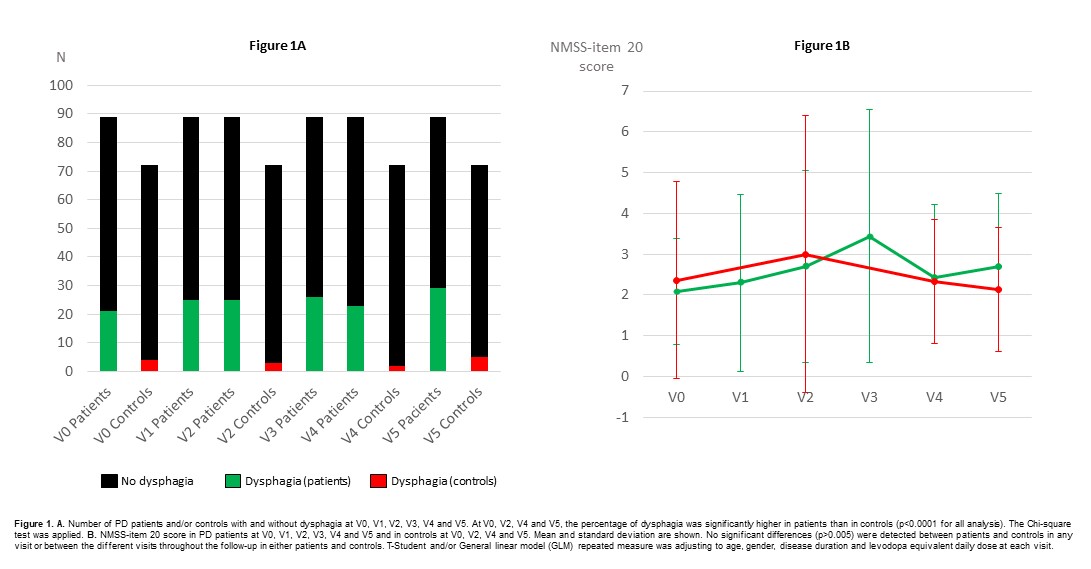Category: Parkinson's Disease: Non-Motor Symptoms
Objective: The aim of the present study was to analyze the frequency of dysphagia in patients with early Parkinson´s disease (PD) and to compare with a control group.
Background: At diagnosis, dysphagia can be present in patients with atypical parkinsonism but it is less frequent in those with PD. However, it could be underestimated.
Method: Patients with early PD (≤ 2 years from symptoms onset) who were recruited from January/2016 to November/2017 (baseline visit; V0) and evaluated annually for 5 years from the Spanish cohort COPPADIS1 were included in this longitudinal prospective study. Subjects from a control group were assessed at baseline and at 2, 4 and 5-year follow-up. At each visit, to have dysphagia was defined as a non-zero score (from 1 to 12) in the item 20 (“Does the patient having difficulty swallowing?”) of the Non-Motor Symptoms Scale (NMSS). A score ≥ 6 was considered as relevant dysphagia burden (from often x severe or frequent x moderate [6 points] to always x severe [12 points]). It was mandatory that all selected participants must have been evaluated at all visits: V0; V1 (at 1-year); V2 (at 2-year); V3 (at 2-year); V4 (at 4-year); V5 (at 5-year).
Results: A total of 89 early PD patients (61 ± 8.6 years old; 53.9% males) and 72 controls (63.1 ± 6.7 years old; 50% males) were included. Dysphagia was clearly more frequent in PD patients than controls (p<0.0001 at V0, V2, V4 and V5): 23.6% at V0, 28.1% at V1, 28.1% at V2, 29.2% at V3, 25.8% at V4 and 32.6% at V5 in patients; 5.6% at V0, 4.2% at V2, 2.8% at V4 and 6.9% at V5 in controls (Figure 1A). Mean score of the NMSS-item 20 was significantly higher in PD patients than controls (p<0.0001 in all visits): V0, 0.6 ± 1.2 vs 0.2 ± 1.2; V2, 0.7 ± 1.6 vs 0.2 ± 1.1; V4, 0.7 ± 1.5 vs 0.1 ± 0.5; V5, 0.7 ± 1.5 vs ± 0.2 ± 0.7. However, no differences between PD patients and controls in the NMSS-item 20 score were detected when only subjects with dysphagia were included (Figure 1B). Relevant dysphagia burden was detected only in 1.1%, 6.6%, 3.3%, 6.7%, 4.5% and 3.3% of the patients at V0, V1, V2, V3, V4 and V5, respectively.
Conclusion: Dysphagia was a very frequent NMS perceived by early PD patients but not in controls. However, it was slight and didn´t progress over time.
Figure 1.
References: 1. Santos García D, Jesús S, Aguilar M, et al.; COPPADIS Study Group. COPPADIS-2015 (COhort of Patients with PArkinson’s DIsease in Spain, 2015): an ongoing global Parkinson’s disease project about disease progression with more than 1000 subjects included. Results from the baseline evaluation. Eur J Neurol 2019;26:1399-1407.
To cite this abstract in AMA style:
D. Santos, T. de Deus, C. Cores, C. íñiguez, L. Samaniego, J. Paz González, S. Jesús, M. Cosgaya, J. García Caldentey, N. Caballol, I. Legarda, J. Hernández Vara, I. Cabo, L. López Manzanares, I. González Aramburu, M. Avila, V. Gómez Mayordomo, V. Nogueira, J. Dotor, C. Borrué, B. Solano, M. álvarez Sauco, L. Vela, S. Escalante, E. Cubo, Z. Mendoza, I. Pareés, P. Sánchez Alonso, G. Alonso Losada, M. Morales, I. Gastón, J. Kulisevsky, M. Seijo, C. Valero, R. Alonso Redondo, M. Buongiorno, C. Ordás, P. Martínez Martín, P. Mir, C. Coppadis. Dysphagia is Frequent in early Parkinson´s Disease. Results from a 5-year Follow-up Study. [abstract]. Mov Disord. 2024; 39 (suppl 1). https://www.mdsabstracts.org/abstract/dysphagia-is-frequent-in-early-parkinsons-disease-results-from-a-5-year-follow-up-study/. Accessed December 14, 2025.« Back to 2024 International Congress
MDS Abstracts - https://www.mdsabstracts.org/abstract/dysphagia-is-frequent-in-early-parkinsons-disease-results-from-a-5-year-follow-up-study/

